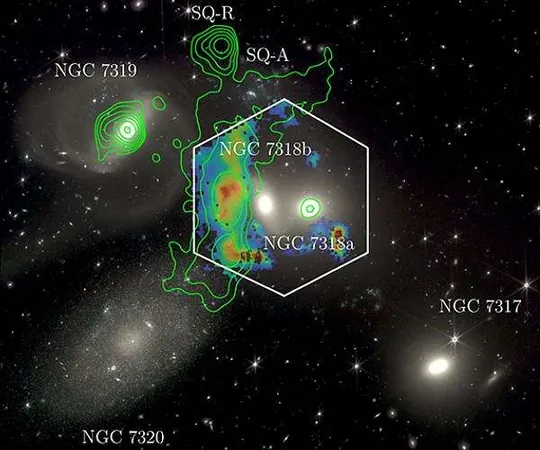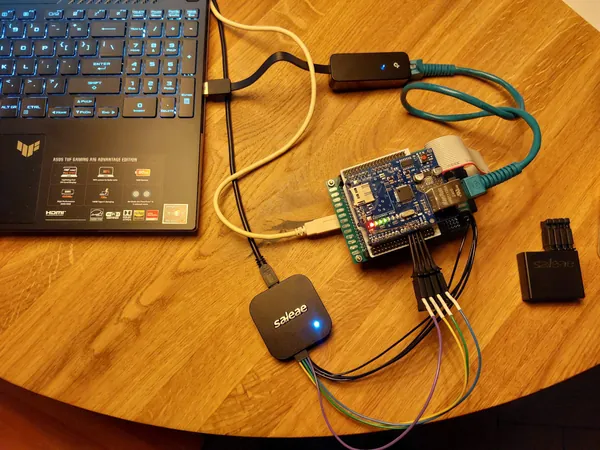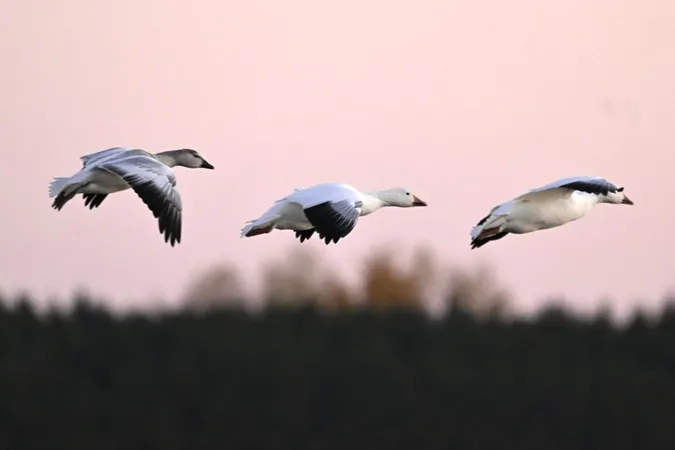
WEAVE's Groundbreaking Discoveries Unveil the Chaos of Galactic Collisions in Stephan's Quintet
2024-11-24
Author: Charlotte
Introduction
In an exciting advancement for astrophysics, early observations from the William Herschel Telescope's Enhanced Area Velocity Explorer (WEAVE) have unveiled significant findings related to Stephan's Quintet, a stunning formation of five galaxies that has captivated astronomers since its discovery in 1877. Led by Dr. Marina Arnaudova from the University of Hertfordshire, a collaborative team of over 50 astronomers has released the first major results from WEAVE, a sophisticated spectrograph that promises to revolutionize our understanding of cosmic phenomena.
Stephan's Quintet Description
Stephan's Quintet consists of NGC 7317, NGC 7318a, NGC 7318b, NGC 7319, and NGC 7320c, and it serves as a unique cosmic laboratory where galactic collisions generate a tumultuous realm filled with complex debris and ongoing activity. The latest research specifically examines NGC 7318b—a galaxy hurtling through space at an astonishing speed of more than 3.2 million kilometers per hour. As it collides with the Quintet, it produces an enormous shockwave akin to a sonic boom, providing a dynamic environment for investigation.
Research Insights and Findings
Dr. Arnaudova commented, 'Stephan's Quintet is the perfect setup to study the chaotic and often violent interactions between galaxies. This system allows us to explore these processes in depth, and we utilized WEAVE's Large Integral Field Unit (LIFU) to conduct our first observations.'
The groundbreaking study, published in the ‘Monthly Notices of the Royal Astronomical Society,’ integrates WEAVE's LIFU data with observations from renowned instruments such as the LOFAR, the Very Large Array (VLA), and the James Webb Space Telescope (JWST). This comprehensive approach has illuminated the dual nature of the shockwave produced during the galactic interactions. Dr. Arnaudova elaborated, 'As the shockwave penetrates regions of cold gas, it travels at several times the speed of sound—powerful enough to dislodge electrons from atoms, leaving behind luminous trails of ionized gas observable through WEAVE.'
Further insights were provided by PhD student Soumyadeep Das, who noted that the shockwave loses strength as it travels through hot gas regions. Instead of causing massive disruptions, the weaker shock compresses this surrounding hot gas, generating radio waves detected by facilities like LOFAR.
Expert Opinions
Dr. Marc Balcells, the Director of the Isaac Newton Group of Telescopes, expressed optimism about WEAVE's potential, stating, 'I'm thrilled that our initial data already yield high-impact results. This is likely just the beginning of major discoveries we expect from WEAVE over the coming years.'
Professor Gavin Dalton, WEAVE's Principal Investigator at RAL Space and the University of Oxford, also emphasized the remarkable detail achieved in these observations. 'WEAVE has provided profound insights into the shock frontier and the ongoing collision dynamics in Stephan's Quintet,' he remarked, 'revealing vital information about the formation and evolution of faint galaxies that lie at the threshold of our detection capabilities.'
The Innovative WEAVE Spectrograph
The WEAVE spectrograph, a €20 million project spearheaded by the Isaac Newton Group of Telescopes, symbolizes a monumental international collaboration involving institutions from the UK, Spain, the Netherlands, France, and Italy. Designed to complement groundbreaking large-scale surveys, including ESA's Gaia, WEAVE is positioned to tackle critical astrophysical questions in the next decade.
Key components of WEAVE include:
- **Fibre Positioner**: Developed by the University of Oxford, supported by the Instituto de Astrofisica de Canarias (IAC).
- **Prime-Focus System**: A collaborative creation of ING, IAC, and SENER, featuring lens polishing by KiwiStar (NZ).
- **Spectrograph**: Fabricated by NOVA (NL) with optical designs from RAL Space (UK).
- **Field Rotator**: Developed by IAC and manufactured by IDOM (ES).
- **LIFU and CCD Systems**: Constructed by NOVA (NL) and Liverpool John Moores University (UK), respectively.
- **Data and Observatory Systems**: Managed by various institutions across the UK, Spain, and Italy.
The WEAVE consortium showcases a remarkable blend of international expertise, exemplifying how global collaboration can drive forward the field of astrophysics and enhance our understanding of the universe.
What Next? Discoveries Await
With its groundbreaking initial results, WEAVE is poised to deepen our knowledge of galactic dynamics and interactions. As astronomers delve deeper into the mysteries of Stephan's Quintet and beyond, we eagerly anticipate new revelations that could redefine our understanding of the cosmos. Stay tuned for future updates from this fascinating frontier of science!









 Brasil (PT)
Brasil (PT)
 Canada (EN)
Canada (EN)
 Chile (ES)
Chile (ES)
 España (ES)
España (ES)
 France (FR)
France (FR)
 Hong Kong (EN)
Hong Kong (EN)
 Italia (IT)
Italia (IT)
 日本 (JA)
日本 (JA)
 Magyarország (HU)
Magyarország (HU)
 Norge (NO)
Norge (NO)
 Polska (PL)
Polska (PL)
 Schweiz (DE)
Schweiz (DE)
 Singapore (EN)
Singapore (EN)
 Sverige (SV)
Sverige (SV)
 Suomi (FI)
Suomi (FI)
 Türkiye (TR)
Türkiye (TR)